Internationally, diamond grades are mainly evaluated based on diamond weight, diamond color, diamond clarity and diamond cut. However, in addition, diamond fluorescence, opalescence, caffeine, etc. are also within the diamond grading criteria. It also has a certain impact on the price. Below is an introduction to the diamond grading standards and the diamond grading table.
Diamonds are a standardized product. Its value is determined by the diamond grade, i.e. diamond weight, cut, color and clarity. Only diamonds evaluated by strict 4C standards know their true value, and the GIA is undoubtedly the world’s most authoritative. Diamond grading is the 4Cs of diamonds, and the following are the criteria for diamond grading.
Diamond Weight (Carat)
Diamond weight is calculated in carats (CT). 1 carat = 0.2 grams = 100 points. 0.75 carats is also called 75 points. The value of diamonds shows an irregular geometric progression as the weight of diamonds increases, and consumers can determine it according to their personal preferences and purchasing power. Generally speaking, only diamonds weighing more than 50 points begin to have collection and investment value. The following is a table of diameters corresponding to different sizes of diamonds:
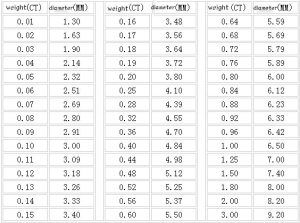

Diamond Clarity
The clarity of a diamond is the amount of water content in the diamond. Most diamonds on the market contain very small, uncrystallized, fine carbon matter. The smaller the amount and volume of inclusions, the better the quality. Diamonds with this clarity are relatively rare and therefore less expensive. Not cheap. Internationally, diamond clarity grades are divided into six major categories, namely FL, IF, VVS, VS, SI, I, and can be further subdivided into several smaller grades.
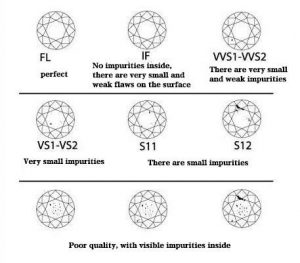
FL means that the diamond is clean under 10x magnification, meaning that there are no inclusions on the inside or outside of the stone.
IF means that under 10x loupe, the diamond is free of flaws on the inside, but may have a little flaw on the surface, which can be removed by polishing.
VVS means that very small flaws can be seen in the pavilion or surface of the diamond when viewed under 10x gem loupe. the difference between VVS1 and VVS2 is that the latter has tiny cotton-like dots and stubble.
VS means that very small flaws can be seen when the diamond is viewed under a 10x gem loupe. the difference between VS1 and VS2 is that the latter may have tiny cotton dots or stubble.
SI means that flaws are easily visible when looking at the diamond under 10x loupe, but are not visible to the naked eye.
I1, I2 and I3 mean that small flaws are easily visible when viewing the diamond under 10x magnification. Some have visible cracks and fissures that can be easily seen with the naked eye.
All diamonds are viewed for clarity with a 10x loupe, only I3 diamonds can be easily seen with the naked eye for flaws
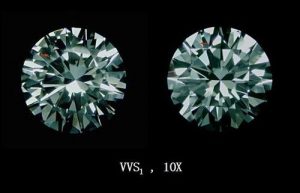
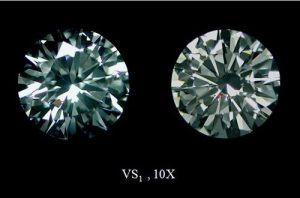
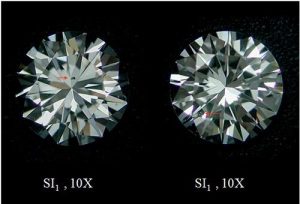
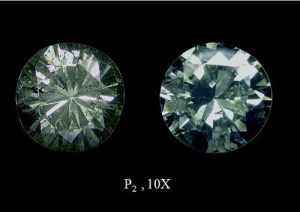
Diamond Color
The color of a regular diamond ranges from completely colorless to yellow and brown. Among them, completely colorless diamonds are very rare and are the highest color grade among ordinary diamonds. Depending on the purity of the color, the color grades of diamonds in the world are divided by letters of the alphabet, starting from D and divided into D, E, F, G, H, I, J, K, L, M, N… The grade decreases in order.

Grade D: Completely colorless. The highest color grade, extremely rare
Grade E: Colorless. Only gemologists can detect traces of color. This is a very rare diamond
F grade: colorless. Only a gemologist can detect a small amount of color, but it is still considered colorless. It is a high quality diamond.
G-H grade: Almost colorless. When compared to higher color diamonds, there is a slight amount of color. However, diamonds of this color grade still have a high value.
Grades I-J: Nearly colorless. Slight color can be detected. Higher value.
K-M grade: Darker color with less fire.
N-Z grade: Darker color, poorer fire color.
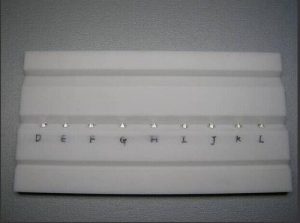
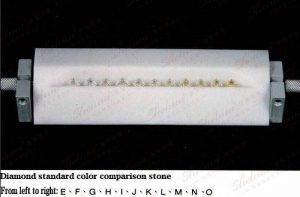
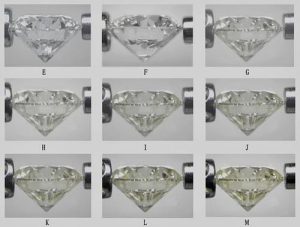
Cutting of diamonds
The diamond cut is the only parameter of the diamond grade that can be manually controlled. The quality of the diamond cut determines the presentation of the diamond’s brilliance. A good cut can even cover up flaws and deficiencies in the diamond itself, so many consumers will have their diamonds cut. The work is the primary focus of buying a diamond. Diamond cut grades are classified as excellent cut, very good cut, good cut, average cut and poor cut.

EXCELLENT: represents a standard that only 3% of first-class high-quality diamonds can achieve. This cut makes the diamond reflect almost all light entering the diamond. It is an elegant and outstanding cut.
VERY GOOD: Represents about 15% of diamond cuts. It can make the diamond reflect the light of standard grade cut, but the price is slightly lower.
GOOD: Represents about 25% of diamond cuts. The diamond reflects most of the light entering the diamond. Much cheaper than VG grade.
FAIR: represents about 35% of diamond cuts, which are still high-quality diamonds, but the light reflected by diamonds with general cuts is not as good as that of G-level cuts.
POOR: This includes all diamonds that do not meet general cut standards. The cuts of these diamonds are either deep and narrow or shallow and wide, which tends to allow light to escape from the edges or bottom, thereby making the diamond lose its luster.
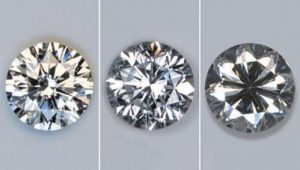
Diamonds of different cut grades
Fluorescence intensity
Thirty-five percent of the world’s diamonds have a fluorescent effect. 97% of fluorescent diamonds emit blue fluorescence, making up the majority, with the remaining 3% being yellow, green, and red, and in between. Fluorescence of transitional colors, such as orange, blue-green, pink, etc. Fluorescence has no effect on the diamond itself, but in some cases it can affect the visual appearance of the diamond.
The intensity level of fluorescence is divided into four levels.” Very Strong”, “Strong”, “Moderate”, “Weak” and “None”. When fluorescence levels are at the “medium” or “strong” level, the diamond’s fluorescence adds a hazy or oily appearance to the diamond, making an almost colorless diamond surface appear whiter, and diamonds with medium or high fluorescence are priced lower than other diamonds.
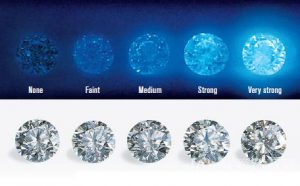
Diamond Milk Caffeine
Milk is a cloudy aggregate of different colors in diamonds, usually white, but not infrequently gray and black. The white ones are usually referred to as “milk”. Its technical term is “cloud” and can affect the clarity and color of a diamond.
Coffee color is an abbreviation for coffee, brown (or tan). Coffee color often appears as a secondary color in primary colors such as yellow, orange, green, pink and red. Other colors include cape colored diamonds, except for the brown color in brown colored diamonds, which is a beneficial color. Intermediate colors are harmful colors, which will severely reduce the purity and brightness of the primary color.
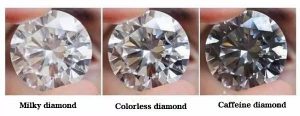
Diamond Comparison
This is a comprehensive introduction to diamonds. Buying a diamond is a matter of comprehensive consideration and personal preference. But there is only one purpose, to spend the least amount of money to get the most suitable diamond, but diamonds are after all luxury items that will not depreciate in value in the current situation. I’m here to make it clear that generally only high grade diamonds of 50 points or more have the significance of retaining their value! So, I would like to remind you here that you should be careful when buying diamonds. The above is the latest content of diamond grade and diamond grade comparison table,
